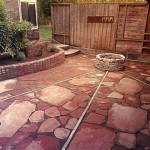How To Build A Small Patio With Pavers and Concrete Stones
Creating an outdoor living space enhances the aesthetic appeal and functionality of any property. A small patio constructed with pavers and concrete stones offers a durable and visually appealing area for relaxation, entertainment, and various outdoor activities. This article provides a comprehensive guide on how to build a small patio using these materials, encompassing planning, preparation, and construction stages.
Planning and Design
The initial phase of any patio construction project involves meticulous planning and design. This stage determines the overall appearance, functionality, and material requirements, ensuring the final product meets the intended purpose and blends seamlessly with the existing landscape. Accurate measurements and a well-defined design are crucial for minimizing errors and optimizing resource utilization.
First, determine the desired size and shape of the patio. Consider the available space and the intended use. A small patio for a bistro set will require less space than one intended for a dining table and chairs. Sketch out a rough design, indicating the dimensions and the proposed layout. This visual representation will serve as a guide throughout the construction process.
Next, evaluate the existing site conditions. Note the slope of the ground, any existing vegetation, and the soil type. A level surface is essential for a stable and even patio. If the ground is uneven, excavation and leveling will be necessary. The soil type will influence the choice of base materials and drainage solutions. In areas with poor drainage, consider incorporating a slightly sloped base to facilitate water runoff.
Select the pavers or concrete stones. Various shapes, sizes, colors, and textures are available. Choose materials that complement the style of the house and the surrounding landscape. Consider the durability and maintenance requirements of each option. Concrete pavers are generally more affordable than natural stone, while natural stone offers a unique and rustic aesthetic. Ensure you order sufficient materials, accounting for cuts and potential wastage. It is generally advisable to order at least 10% more materials than calculated to accommodate unforeseen circumstances.
Finally, develop a detailed plan indicating the layout of the pavers or stones. Consider patterns such as running bond, herringbone, or basketweave. These patterns affect the visual appeal and the stability of the patio. Mark the planned layout on the ground using stakes and string or spray paint. This will serve as a reference during the excavation and installation phases.
Site Preparation and Excavation
Proper site preparation is paramount for ensuring the long-term stability and integrity of the patio. This phase involves removing existing vegetation, excavating the area, and constructing a solid base. A well-prepared base prevents shifting, settling, and weed growth, leading to a durable and aesthetically pleasing patio.
Begin by removing any existing vegetation, including grass, weeds, and shrubs, from the area designated for the patio. Use a shovel or a sod cutter to remove the vegetation and its root system. Ensure that all organic matter is cleared to prevent decomposition and potential settling. Dispose of the removed vegetation appropriately.
Next, excavate the area to the required depth. The depth will depend on the type of base material used and the desired finished height of the patio. As a general guideline, excavate approximately 6-8 inches below the planned finished grade. This depth allows for a 4-inch base of compacted gravel and a 1-2 inch layer of sand setting bed. Use a shovel and wheelbarrow to remove the excavated soil. Check the depth regularly using a level and measuring tape to ensure uniformity.
After excavation, compact the exposed soil using a plate compactor. This will provide a stable foundation for the base material. Overlap each pass of the compactor to ensure complete coverage. Compaction is crucial for preventing settling and shifting over time. If the soil is excessively dry, lightly dampen it before compaction to improve its binding properties.
Install edge restraints along the perimeter of the patio. Edge restraints prevent the pavers or stones from shifting and maintain the shape of the patio. Options include plastic edging, metal edging, or concrete curbing. Secure the edge restraints in place using stakes or concrete adhesive as recommended by the manufacturer. Ensure that the edge restraints are level and flush with the planned finished grade.
Install the base material. Typically, crushed gravel or compacted road base is used. Spread the base material evenly over the excavated area to a depth of approximately 4 inches. Use a rake to distribute the material uniformly. Compact the base material using a plate compactor. This step is crucial for creating a stable and level foundation for the pavers or stones. Ensure that the base is properly compacted to prevent settling and shifting over time.
Laying Pavers and Finishing
The final stage involves laying the pavers or concrete stones according to the planned layout and finishing the patio with joint sand or polymeric sand. Precise execution during this phase determines the overall appearance and functionality of the patio. Proper leveling, spacing, and joint filling are essential for creating a visually appealing and durable surface.
Spread a layer of sand setting bed over the compacted base material. The sand should be approximately 1-2 inches thick. Use a screed board to level the sand. This will ensure a smooth and even surface for laying the pavers or stones. The sand setting bed allows for minor adjustments to ensure that the pavers or stones are perfectly level.
Begin laying the pavers or stones according to the planned layout. Start at one corner and work your way across the patio. Use a rubber mallet to gently tap each paver or stone into place. This will ensure that it is firmly seated in the sand setting bed. Maintain consistent spacing between the pavers or stones. Use spacers or string lines to ensure uniformity. Check the level of each paver or stone using a level. Make adjustments as needed by adding or removing sand from the setting bed.
Cut pavers or stones as needed to fit around edges and corners. Use a paver splitter or a wet saw to make clean and precise cuts. Safety glasses and gloves should be worn during any cutting process and be performed by individuals with experience using these tools.
Once all the pavers or stones are laid, sweep joint sand or polymeric sand into the joints. Joint sand is a fine sand that fills the gaps between the pavers or stones, providing stability and preventing weed growth. Polymeric sand contains additives that bind the sand together, creating a more durable and weed-resistant joint. Follow the manufacturer's instructions for applying joint sand or polymeric sand. Typically, the sand is swept into the joints, and then the patio is lightly watered to activate the binding agents.
Compact the pavers or stones a final time using a plate compactor with a rubber pad attachment. This will help to seat the pavers or stones firmly in the sand setting bed and ensure that the joints are completely filled with sand. Avoid over-compacting the pavers or stones, as this can damage them. Sweep away any excess sand from the surface of the patio. Allow the patio to dry completely before using it.
The final step is to seal the patio. Sealing the patio will help to protect it from stains and weathering. It will also enhance the color and appearance of the pavers or stones. Choose a sealant that is specifically designed for pavers or concrete stones. Follow the manufacturer's instructions for applying the sealant. Typically, the sealant is applied with a roller or sprayer. Allow the sealant to dry completely before using the patio.

How To Diy A Concrete Paver Pea Gravel Patio The Collected House

How To Build A Patio An Easy Do It Yourself Project

How To Build A Patio In Weekend Fine Gardening

Diy Pea Gravel Patio With Pavers Love Renovations

Paver Patios Install A Diy Patio With Brick Or Stone Decks Com

How To Lay A Patio With Pavers Diy Over Dirt No Concrete Needed Amber Oliver

See How 3 Patios Ingeniously Mix Pavers And Pebbles

We Built A Paver Patio Like Pro Start To Finish

How To Build A Paver Patio Young House Love

Diy Pea Gravel Patio With Pavers Love Renovations
Related Posts








